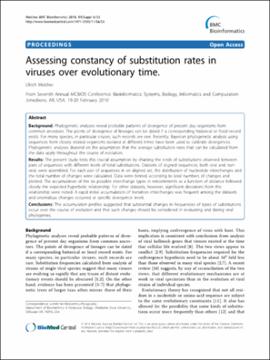| dc.contributor.author | Melcher, Ulrich | |
| dc.date.accessioned | 2018-11-09T21:10:48Z | |
| dc.date.available | 2018-11-09T21:10:48Z | |
| dc.date.issued | 2010-10-07 | |
| dc.identifier | oksd_melcher_assessingconsta_2010 | |
| dc.identifier.citation | Melcher, U. (2010). Assessing constancy of substitution rates in viruses over evolutionary time. BMC Bioinformatics, 11(Suppl 6), Article S3. https://doi.org/10.1186/1471-2105-11-S6-S3 | |
| dc.identifier.uri | https://hdl.handle.net/11244/302058 | |
| dc.description.abstract | Background: Phylogenetic analyses reveal probable patterns of divergence of present day organisms from common ancestors. The points of divergence of lineages can be dated if a corresponding historical or fossil record exists. For many species, in particular viruses, such records are rare. Recently, Bayesian phylogenetic analysis using sequences from closely related organisms isolated at different times have been used to calibrate divergences. Phylogenetic analyses depend on the assumption that the average substitution rates that can be calculated from the data apply throughout the course of evolution. | |
| dc.description.abstract | Results: The present study tests this crucial assumption by charting the kinds of substitutions observed between pairs of sequences with different levels of total substitutions. Datasets of aligned sequences, both viral and non-viral, were assembled. For each pair of sequences in an aligned set, the distribution of nucleotide interchanges and the total number of changes were calculated. Data were binned according to total numbers of changes and plotted. The accumulation of the six possible interchange types in retroelements as a function of distance followed closely the expected hyperbolic relationship. For other datasets, however, significant deviations from this relationship were noted. A rapid initial accumulation of transition interchanges was frequent among the datasets and anomalous changes occurred at specific divergence levels. | |
| dc.description.abstract | Conclusions: The accumulation profiles suggested that substantial changes in frequencies of types of substitutions occur over the course of evolution and that such changes should be considered in evaluating and dating viral phylogenies. | |
| dc.format | application/pdf | |
| dc.language | en_US | |
| dc.publisher | BioMed Central | |
| dc.rights | This material has been previously published. In the Oklahoma State University Library's institutional repository this version is made available through the open access principles and the terms of agreement/consent between the author(s) and the publisher. The permission policy on the use, reproduction or distribution of the material falls under fair use for educational, scholarship, and research purposes. Contact Digital Resources and Discovery Services at lib-dls@okstate.edu or 405-744-9161 for further information. | |
| dc.title | Assessing constancy of substitution rates in viruses over evolutionary time | |
| osu.filename | oksd_melcher_assessingconsta_2010.pdf | |
| dc.description.peerreview | Peer reviewed | |
| dc.identifier.doi | 10.1186/1471-2105-11-S6-S3 | |
| dc.description.department | Biochemistry and Molecular Biology | |
| dc.type.genre | Article | |
| dc.type.material | Text | |
| dc.subject.keywords | rbcL | |
| dc.subject.keywords | tomato yellow leaf curl virus | |
| dc.subject.keywords | tomato yellow leaf | |
| dc.subject.keywords | wheat streak mosaic virus | |
| dc.subject.keywords | accumulation profile | |
